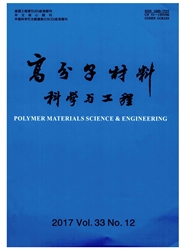

 中文摘要:
中文摘要:
在熔体的流动过程中叠加脉动的压力振幅,研究了压力振动场对聚合物熔体的流动性能的影响。表观黏度随着压力振幅、振频的增加而明显下降.当压力振幅为29.7MPa时,高密度聚乙烯(HDPE)、聚丙烯(PP)和丙烯腈-丁二烯-苯乙烯共聚物(ABS)表现黏度最大的降低幅度分剐为99%、99%和94.3%;随着振频的增加,黏度迅速下降,当振频大于0.70Hz之后.增加振频对黏度的影响不大,HDPE、PP和ABS表观黏度随振频增加而降低,幅度分剐为48.9%、82.9%、66.7%.可见压力振动场能明显地改善聚合物熔体的流动行为。
 英文摘要:
英文摘要:
In the paper, the pulsing pressure vibration is creatively superposed to the flowing melt, and originates the study on melt properties through pressure vibration. The pressure vibration field can improve polymer meh's rheological properties. At constant pressure vibration amplitude, the apparent viscosity decrease greatly in low ranges of vibration frequency (0-0.7Hz), and then tends to plateau. For HDPE, PP and ABS, the maximal decreasing percentages are 48. 9%, 82.9% and 66. 7%, respectively. At a constant vibration frequency, the apparent viscosity decreases greatly with increasing pressure vibration amplitude. When the vibration amplitude is 29. 7 MPa, the decrease percentages are 99%, 99% and 94. 3% for HDPE, PP and ABS, respectively. Compared with the effects of melt shear vibration, the pressure vibration can improve the melt rheological behavior greatly.
 同期刊论文项目
同期刊论文项目
 同项目期刊论文
同项目期刊论文
 Gas-assisted Injection Molded Polypropylene/Glass Fiber Composite: Foaming Structure and Tensile Str
Gas-assisted Injection Molded Polypropylene/Glass Fiber Composite: Foaming Structure and Tensile Str 期刊信息
期刊信息
